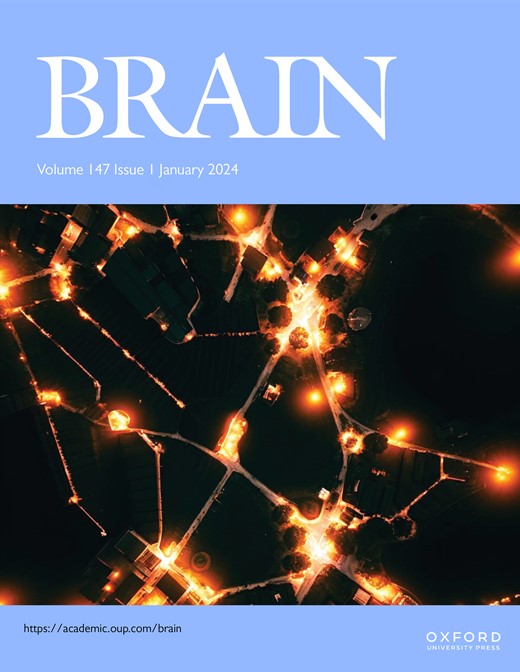不同的小脑网络支持青少年妥瑞症的临床改善。
IF 11.7
1区 医学
Q1 CLINICAL NEUROLOGY
引用次数: 0
摘要
青春期通常被称为大脑的第二个成熟期。在抽动秽语症(TD)中,抽动症和相关精神合并症的临床轨迹在从青少年到成年的过渡期间因人而异。在这项研究中,我们旨在识别静息状态功能连接模式,以区分患有TD的青少年与神经正常的同龄人,并监测症状特异性功能随时间的变化。我们采用基于支持向量机(SVM)的多变量分析来预测64名青少年TD和61名性别和年龄匹配的健康对照(HC)的静息状态功能连接模式。57例TD患者两次参与,每次间隔15个月。基于多变量分析的结果,我们实施了一个一般线性模型,测试静息状态功能连通性随时间的组内差异,以及它们与抽搐、抑郁、强迫症(OCD)和注意缺陷多动症(ADHD)症状严重程度变化的相关性。支持向量机以高于机会的准确度、特异度和灵敏度区分出TD和HC。最具区别性的连接是前额叶、纹状体和小脑网络。在两次访问之间,患有TD的青少年表现出蚓蚓3与双侧辅助运动区以及蚓蚓4、5与枕叶皮质之间的功能连通性下降。相关性分析证明:(1)抽动严重程度的改善与前辅助运动皮层、前扣带和额下回之间的连通性增加有关;(ii) ADHD的改善与前扣带皮层与下颞叶皮层的连通性下降有关;(iii)强迫症的改善与小脑(小叶8和蚓部8、9)与额极、颞上和额上皮质的连通性降低,小脑-顶叶、额顶叶和额额连通性增加相关;(iv)抑郁症状的改善与小脑(小叶4、小叶5和小脑6)与楔前叶的连通性下降有关。我们的研究结果支持了TD的病理生理模型,其中功能连接的异常模式与特定的合并症有关,这些合并症可能在整个青春期以不同的方式进化。静息状态功能连接可能提供独特的内表型,其发育变化可能与合并症严重程度的改变有关。小脑的不同区域及其与不同额叶皮质区域的连通性成为监测和可能预测TD症状临床轨迹的候选生物标志物,为疾病发病机制提供见解,并可能指导临床决策。本文章由计算机程序翻译,如有差异,请以英文原文为准。
Distinct cerebellar networks underpin clinical improvement in adolescent Tourette disorder.
Adolescence is frequently called the second brain maturation period. In Tourette disorder (TD), the clinical trajectory of tics and associated psychiatric co-morbidities vary significantly across individuals during the transition from adolescents to adulthood. In this study, we aimed to identify patterns of resting-state functional connectivity that differentiate adolescents with TD from their neurotypical peers, and to monitor symptom-specific functional changes over time. We employed multivariate analysis based on support vector machine (SVM) to predict patterns of resting-state functional connectivity in 64 adolescents with TD and 61 sex- and age-matched healthy controls (HC). 57 TD patients participated twice, at a time interval of 15 months. Based on the results of the multivariate analysis, we implemented a general linear model testing within-group differences in resting-state functional connectivity over time, as well as their correlation with changes in severity of tics, depressive, obsessive-compulsive (OCD) and attention deficit and hyperactivity (ADHD) symptoms. SVM significantly discriminated TD from HC with above-chance accuracy, specificity and sensitivity. The most discriminative connections were prefrontal, striatal and cerebellar networks. Between the visits, adolescents with TD showed decreased functional connectivity between the vermis 3 and the bilateral supplementary motor area, and between the vermis 4,5 and the occipital cortex. The correlation analysis evidenced that (i) an improvement between the visits in the severity of tics was associated with increased connectivity between the pre-supplementary motor cortex, anterior cingulate and inferior frontal gyrus; (ii) an improvement of ADHD was associated with decreased connectivity of the anterior cingulate cortex with the inferior temporal cortex; (iii) an improvement of OCD correlated with decreased cerebellar (lobule 8 and vermis 8, 9) connectivity with fronto-polar, superior temporal and superior frontal cortices, and increased cerebello-parietal connectivity, as well as fronto-parietal and fronto-frontal connectivity; and (iv) an improvement of depressive symptoms correlated with decreased connectivity of the cerebellum (lobule 4, 5 and vermis 6) with the precuneus. Our findings support pathophysiological models of TD in which aberrant patterns of functional connectivity are related to specific comorbidities, that may evolve differently throughout adolescence. Resting-state functional connectivity may provide unique endophenotypes with developmental changes potentially linked to the modification of severity of comorbid conditions. Distinct regions of the cerebellum and its connectivity with various frontal cortical regions emerge as candidate biomarkers to monitor, and possibly predict, the clinical trajectory of TD symptoms, offering insights into disorder pathogenesis and likely guide clinical decision-making.
求助全文
通过发布文献求助,成功后即可免费获取论文全文。
去求助
来源期刊

Brain
医学-临床神经学
CiteScore
20.30
自引率
4.10%
发文量
458
审稿时长
3-6 weeks
期刊介绍:
Brain, a journal focused on clinical neurology and translational neuroscience, has been publishing landmark papers since 1878. The journal aims to expand its scope by including studies that shed light on disease mechanisms and conducting innovative clinical trials for brain disorders. With a wide range of topics covered, the Editorial Board represents the international readership and diverse coverage of the journal. Accepted articles are promptly posted online, typically within a few weeks of acceptance. As of 2022, Brain holds an impressive impact factor of 14.5, according to the Journal Citation Reports.
 求助内容:
求助内容: 应助结果提醒方式:
应助结果提醒方式:


